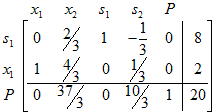

Given the initial simplex tableaux below, use the simplex algorithm to maximize the objective function P. Your answer should include the values for x1, x2, s1, s2, and P. For each pivot operation write down the row operations you did on your calculator and the resulting tableau.

The pivot column is the first column since -10 is the most negative value in the bottom row.
To determine the pivot row, divide the last element in each row (except the last) by the corresponding element in the pivot column (in this case, the first column). In the first row we get a quotient of 10/1 = 10 and in the second row we get a quotient of 6/3 = 2. Since the smallest quotient is 2, we choose the second row as the pivot row. The pivot element (3) is the element at the intersection of the pivot row and the pivot column:

The goal is to replace the 1 in the first row with 0, replace the 3 (the pivot element) with 1, and replace the -10 in the last row with 0. If the initial tableau is stored as matrix A, the necessary row operations are:
*row( 1/3, [A], 2) *row+(-1, Ans, 2, 1) *row+(10, Ans, 2, 3)
The new tableau is

I've shown values as rational numbers. They will be displayed as decimal equivalents on your calculator. Since all of the values in the bottom row are positive, this tableau represents the solution to the maximization problem:
The non-basic variables are zero:
x2 = 0
s2 = 0
The values of the basic variables and the objective function are given in the last column:
s1 = 8
x1 = 2
Maximum P = 20